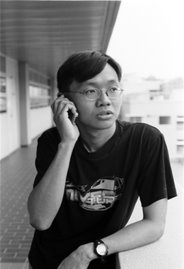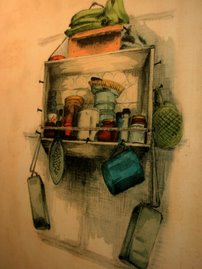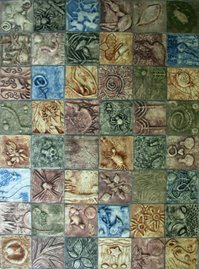
(A commemorative book on Semakau Landfill by NEA)
After completing my 21km race in the sundown marathon around 12+am with my colleague, AWC on 30May10, we shared a cab home to get some rest before carrying on with the Semakau Landill visit early in the morning at 5am. Actually I did not sleep at all after the race because it was already 3 am after I finished bathing and I need to leave home to walk to Yew Tee CC to board the coach to Marina South Pier with AWC & his wife. AWC actually invited me for this semakau landfill visit and I was quite interested since I have not been there before.



(Taking to Ferry from Marina South Pier to Semakau Landfill - View of the sunrise from the ferry)
A brief introduction of the Semakau Landfill

(Map of Semakau Landfill)
Before Semakau landfill started its operation, there were 2 islands, Pulau Sakeng and Pulau Semakau where kampong life used to be. The isolation of the 2 islands ended in 1990s when the government has a plan to merge both the islands together to form Semakau Landill which covers a area of 350 hectares to utilize the space for Singapore waste landfill and the construction started in 1995. FYI. Semakau Landfill is 8km south of Singapore.
The landfill was formed by enclosing the sea space between the 2 islands with a 7km perimeter rock bund and divided into 11 landfill cells and 1 large phase 2 cell which can serve up to year 2030+. Rubbishes are not dumped directly into the landfill cells but the waste are collected in Singapore Mainland and incinerated into ash and brought to the Tuas Marine Transfer Station (TMTS). From there, the ash and non-incinerable waste are loaded on the barges and transported to Semakau Landfill on a 3 hour, 30km journey by specially designed tugboat.
The ash and non-incinerable waste are then discharged into the landfill cells and compacted by bulldozers. After each cell has been filled, earth will be covered over it and grass and trees will take root by nature. Beside the landfill, there are also nature ecosystems at the western side of the Semakau landfill where thick mangrove forest and rich coral reefs can be found. This also gives another alternative for nature lovers for a visit to the island.
More information of Semakau Landfill can be found below.
http://en.wikipedia.org/wiki/Pulau_Semakau
http://www.nea.gov.sg/cms/wmd/SL%20Brochure.pdf
http://www.wildsingapore.com/places/semakau.htm
http://www.channelnewsasia.com/stories/singaporelocalnews/view/387313/1/.html
http://www.news.gov.sg/public/sgpc/en/media_releases/agencies/nea/press_release/P-20090808-1
Coming back to my topic on the trip. After a 45minutes ferry journey, Our tour group of about 60 participants finally arrived at Semakau Landfill Vistor Centre. From there, we were split into 4 groups consisting of around 15 participants and each team was led by a guide. We were guided along the 2km route on a quiet runway towards the western part of the landfill (Pulau Semakau) to have the intertidal walk at the low tide to view the marine life, mangroves and rich coral reefs.

(Semakau Landfill Visitor Centre)


(Walking on the roadway - Seperating between the road are the landfill cells and the mangrove forest)


-Reached the entrance area to intertidal walk after a 2km walk from visitor centre
- Map of major ecosystems on Pulau Semakau




(Information boards before intertidal walk entrance area + walking through the forest to get to the shore)
The intertidal walk was a great one as we got a chance to walk on the intertidal reef flat and observe many interesting marine life, starfish, coral etc. The only problem that all of the participants need to face was to be receive sudden attacks for the “Ninja Mosquitoes” that was mentioned by the guides. : ( After the intertidal walk, we walked back to the main roadway to wash our legs with the large pails of rainwater provided before boarding a van back to the visitor centre. On the van, the guide explained to us about the brief function Semakau Landfill and what other recreational activities can be done on the island.








(Intertidal walk)




Top left to bottom right
- Brain Coral
- Thick Ping Sponge
- Anemones
- Crab


- Starfish. Not sure what is on the 2nd photo


- Tangled Sponge. Not sure what is on the 2nd photo
At the visitor centre, we were directed into a presentation room where a video on the waste management and how the Semakau landfill operates was presented to us. From the video, we got to know that The Semakau Landfill does not last forever as a dumping ground for our rubbish wastes and all the landfill cells were estimated to be occupied by the year 2030+. Therefore the government always urge to the public not to simply throw all rubbish, but to reduce, reuse and recycle our rubbish. Recycling Bins were located all round Singapore Mainland to collect certain rubbish such as paper, glass which can be recycled into new products.
After the video presentation at around 11+am, we waited for the ferry to arrive for our trip back to Singapore Mainland. Overall it was an eye opening trip for me to get to visit a landfill and to learn how the waste management works and have fun at the interesting intertidal walk as well. It was certainly a place worth for a visit to avoid the busy life in Singapore.



(Taking to Ferry from Marina South Pier to Semakau Landfill - View of the sunrise from the ferry)
A brief introduction of the Semakau Landfill

(Map of Semakau Landfill)
Before Semakau landfill started its operation, there were 2 islands, Pulau Sakeng and Pulau Semakau where kampong life used to be. The isolation of the 2 islands ended in 1990s when the government has a plan to merge both the islands together to form Semakau Landill which covers a area of 350 hectares to utilize the space for Singapore waste landfill and the construction started in 1995. FYI. Semakau Landfill is 8km south of Singapore.
The landfill was formed by enclosing the sea space between the 2 islands with a 7km perimeter rock bund and divided into 11 landfill cells and 1 large phase 2 cell which can serve up to year 2030+. Rubbishes are not dumped directly into the landfill cells but the waste are collected in Singapore Mainland and incinerated into ash and brought to the Tuas Marine Transfer Station (TMTS). From there, the ash and non-incinerable waste are loaded on the barges and transported to Semakau Landfill on a 3 hour, 30km journey by specially designed tugboat.
The ash and non-incinerable waste are then discharged into the landfill cells and compacted by bulldozers. After each cell has been filled, earth will be covered over it and grass and trees will take root by nature. Beside the landfill, there are also nature ecosystems at the western side of the Semakau landfill where thick mangrove forest and rich coral reefs can be found. This also gives another alternative for nature lovers for a visit to the island.
More information of Semakau Landfill can be found below.
http://en.wikipedia.org/wiki/Pulau_Semakau
http://www.nea.gov.sg/cms/wmd/SL%20Brochure.pdf
http://www.wildsingapore.com/places/semakau.htm
http://www.channelnewsasia.com/stories/singaporelocalnews/view/387313/1/.html
http://www.news.gov.sg/public/sgpc/en/media_releases/agencies/nea/press_release/P-20090808-1
Coming back to my topic on the trip. After a 45minutes ferry journey, Our tour group of about 60 participants finally arrived at Semakau Landfill Vistor Centre. From there, we were split into 4 groups consisting of around 15 participants and each team was led by a guide. We were guided along the 2km route on a quiet runway towards the western part of the landfill (Pulau Semakau) to have the intertidal walk at the low tide to view the marine life, mangroves and rich coral reefs.

(Semakau Landfill Visitor Centre)


(Walking on the roadway - Seperating between the road are the landfill cells and the mangrove forest)


-Reached the entrance area to intertidal walk after a 2km walk from visitor centre
- Map of major ecosystems on Pulau Semakau




(Information boards before intertidal walk entrance area + walking through the forest to get to the shore)
The intertidal walk was a great one as we got a chance to walk on the intertidal reef flat and observe many interesting marine life, starfish, coral etc. The only problem that all of the participants need to face was to be receive sudden attacks for the “Ninja Mosquitoes” that was mentioned by the guides. : ( After the intertidal walk, we walked back to the main roadway to wash our legs with the large pails of rainwater provided before boarding a van back to the visitor centre. On the van, the guide explained to us about the brief function Semakau Landfill and what other recreational activities can be done on the island.








(Intertidal walk)




Top left to bottom right
- Brain Coral
- Thick Ping Sponge
- Anemones
- Crab


- Starfish. Not sure what is on the 2nd photo


- Tangled Sponge. Not sure what is on the 2nd photo
At the visitor centre, we were directed into a presentation room where a video on the waste management and how the Semakau landfill operates was presented to us. From the video, we got to know that The Semakau Landfill does not last forever as a dumping ground for our rubbish wastes and all the landfill cells were estimated to be occupied by the year 2030+. Therefore the government always urge to the public not to simply throw all rubbish, but to reduce, reuse and recycle our rubbish. Recycling Bins were located all round Singapore Mainland to collect certain rubbish such as paper, glass which can be recycled into new products.
After the video presentation at around 11+am, we waited for the ferry to arrive for our trip back to Singapore Mainland. Overall it was an eye opening trip for me to get to visit a landfill and to learn how the waste management works and have fun at the interesting intertidal walk as well. It was certainly a place worth for a visit to avoid the busy life in Singapore.


- Tugboat for solid waste barges
- Transfer Building at Semakau Landfill


(Inside the transfer building at Semakau Landfill -Photo taken in a van)

(Group Photo on the ferry during the trip back Singapore Mainland)








































No comments:
Post a Comment